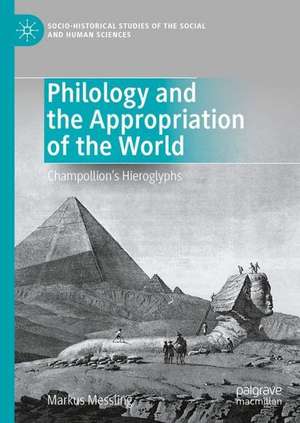Philology and the Appropriation of the World: Champollion’s Hieroglyphs: Socio-Historical Studies of the Social and Human Sciences
Autor Markus Messlingen Limba Engleză Hardback – 12 apr 2023
Preț: 726.06 lei
Preț vechi: 885.44 lei
-18% Nou
Puncte Express: 1089
Preț estimativ în valută:
138.93€ • 145.07$ • 114.72£
138.93€ • 145.07$ • 114.72£
Carte tipărită la comandă
Livrare economică 15-29 aprilie
Preluare comenzi: 021 569.72.76
Specificații
ISBN-13: 9783031128936
ISBN-10: 3031128931
Pagini: 187
Ilustrații: XX, 187 p. 27 illus.
Dimensiuni: 148 x 210 x 18 mm
Greutate: 0.4 kg
Ediția:2023
Editura: Springer International Publishing
Colecția Palgrave Macmillan
Seria Socio-Historical Studies of the Social and Human Sciences
Locul publicării:Cham, Switzerland
ISBN-10: 3031128931
Pagini: 187
Ilustrații: XX, 187 p. 27 illus.
Dimensiuni: 148 x 210 x 18 mm
Greutate: 0.4 kg
Ediția:2023
Editura: Springer International Publishing
Colecția Palgrave Macmillan
Seria Socio-Historical Studies of the Social and Human Sciences
Locul publicării:Cham, Switzerland
Cuprins
1. Other Narratives of a Grand History.- 2. Philology and Nationalism.- 3. Knowledge and Method: The Parisian Legacy.- 4. Civilisational Genealogies: Where Does Europe Come from?.- 5. Scientific Recognition: Showdown in Rome.- 6. History of Materials: Predatory Exploitation on the Nile and the Idea of Protecting Cultural Goods.- 7. Note to the Attention of the Viceroy for the Conservation of the Monuments of Egypt.
Notă biografică
Markus Messling is full professor of Romance Literature and Comparative Literary and Cultural Studies at Saarland University, Germany. He has published on French and Francophone literature and cultural philosophy (18th–21st century), the epistemology and history of philology, historical anthropology and the problem of universalism.
Textul de pe ultima copertă
This book sheds new light on the work of Jean-François Champollion by uncovering a constellation of epistemological, political, and material conditions that made his decipherment of Egyptian hieroglyphs possible. Champollion’s success in understanding hieroglyphs, first published in his Lettre à M. Dacier in 1822, is emblematic of the triumphant achievements of comparative philology during the 19th Century. Yet, precisely because of its success, his project also reveals the costs it entailed: after examining and welcoming acquisitions for the emerging Egyptian collections in Europe, Champollion travelled to the Nile Valley in 1828/29, where he was shocked by the damage that had been done to its ancient cultural sites. The letter he wrote to the Egyptian viceroy Mehmet Ali Pasha in 1829 demands that excavations in Egypt be regulated, denounces European looting, and represents perhaps the first document to make a case for the international protection of cultural goods in the name of humanity.
Caracteristici
Includes unpublished material of Champollion’s hand from the Bibliothèque nationale de France Marks the bicentenary of Champollion’s decipherment of the hieroglyphs Offers epistemological, political, and material insight into Champollion’s work






